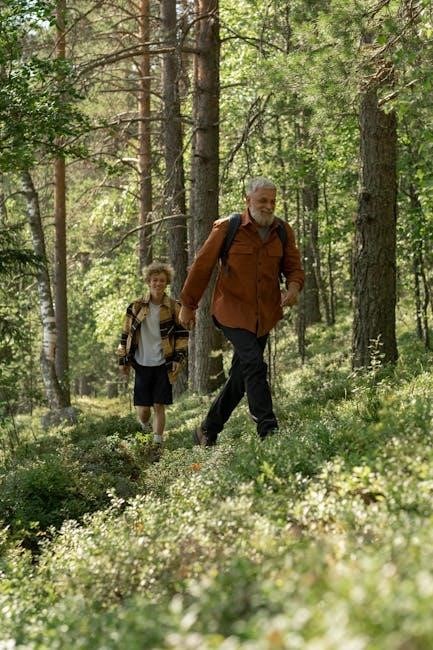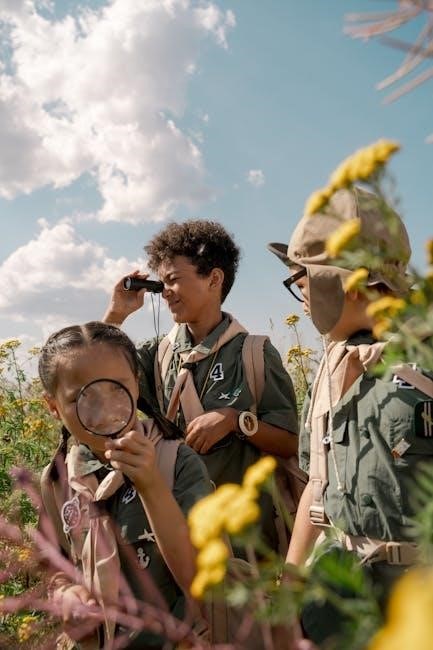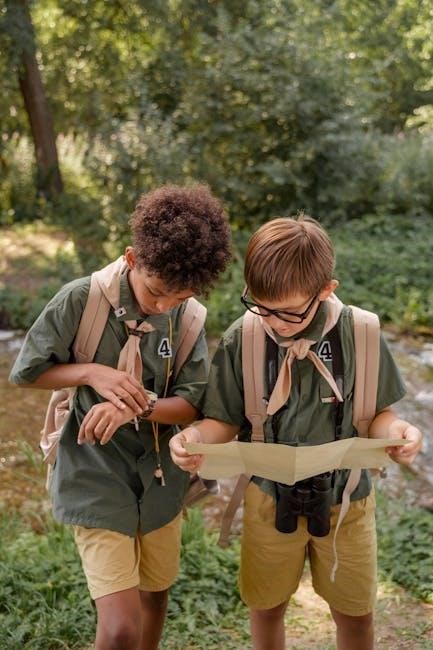trail guide to learning
Summary
Explore the best learning trails and educational resources. Your journey to knowledge starts here!

The Trail Guide to Learning is a comprehensive homeschool curriculum integrating geography, history, science, and language arts through a unit study approach, adaptable for multiple grade levels.
Overview of the Curriculum
The Trail Guide to Learning is a comprehensive homeschool curriculum designed to integrate geography, history, science, and language arts through a unit study approach. It offers a flexible, literature-based framework that encourages hands-on learning and critical thinking. Each level covers a range of three grade levels, making it adaptable for teaching multiple children simultaneously. The curriculum emphasizes exploration and creativity, incorporating art, literature, and practical activities to create an engaging educational experience for homeschooling families.
Key Features and Benefits
The Trail Guide to Learning combines Charlotte Mason’s and Ruth Beechick’s educational philosophies, offering a unit study approach that integrates geography, history, science, and language arts. It provides hands-on activities, literature-based learning, and adaptability for multiple grade levels. This curriculum fosters critical thinking, creativity, and a love for learning through engaging, real-world applications, making it ideal for families seeking a flexible and comprehensive homeschool solution.

Philosophical Foundations
The Trail Guide to Learning blends Charlotte Mason’s natural education, Ruth Beechick’s focus on thinking skills, and Benjamin Bloom’s taxonomy, fostering critical thinking and a love for learning.
Influence of Charlotte Mason’s Methods
Charlotte Mason’s natural education philosophy profoundly influences the Trail Guide to Learning. Emphasizing living books, nature, and a child-led approach, it fosters curiosity and critical thinking. Mason’s belief in children as born persons with innate curiosity is reflected in the curriculum’s focus on literature-rich learning and hands-on exploration. The integration of geography, history, and science into cohesive unit studies mirrors Mason’s holistic view of education, encouraging deep connections and a love for learning across subjects and ages.
Dr. Ruth Beechick’s Educational Philosophy
Dr. Ruth Beechick’s educational philosophy emphasizes the development of thinking skills and language arts through a natural, integrated approach. Her methods stress the importance of adaptability, allowing families to teach multiple ages together with flexibility. Beechick’s focus on meaningful learning experiences, rather than rote memorization, aligns with the Trail Guide to Learning series, which incorporates her principles into a cohesive, literature-based curriculum. Her influence ensures a balanced, effective, and engaging educational journey for homeschooling families.
Integration of Dr. Benjamin Bloom’s Taxonomy
The Trail Guide to Learning series seamlessly integrates Dr. Benjamin Bloom’s Taxonomy, fostering critical thinking and higher-order learning skills. By incorporating Bloom’s framework, the curriculum encourages students to move beyond mere knowledge retention to analysis, synthesis, and evaluation. This approach ensures that learners develop a deeper understanding of subjects, promoting intellectual growth and creativity. The integration of Bloom’s Taxonomy enriches the educational experience, aligning with the curriculum’s goal of producing engaged, thoughtful, and capable learners.

Curriculum Structure and Design
The Trail Guide to Learning uses a flexible, unit-study approach, integrating geography, history, and language arts into cohesive lessons adaptable for teaching multiple grade levels together effectively.
Unit Study Approach
The Trail Guide to Learning employs a unit study approach, seamlessly integrating geography, history, science, and language arts into cohesive, engaging lessons. This method encourages deep exploration of topics, fostering critical thinking and connections between subjects. By focusing on real books, hands-on activities, and meaningful projects, the curriculum creates a dynamic learning environment. Designed to adapt to multiple grade levels, it promotes family learning and flexibility, making it ideal for homeschooling families seeking a comprehensive, literature-rich education rooted in proven educational philosophies.
Geography and History Integration
The Trail Guide to Learning seamlessly integrates geography and history, creating a cohesive framework for understanding the world. By embedding historical events within their geographical contexts, the curriculum fosters a deeper appreciation of how places and cultures have shaped human experiences. Students explore real-life explorers and pioneers, using their journeys as a lens to study history and geography. This approach makes learning immersive and engaging, while adapting to cover three grade levels, ensuring a comprehensive and interconnected educational experience.
Coverage of Science, Art, and Language Arts
The Trail Guide to Learning integrates science, art, and language arts seamlessly into its curriculum. Science is explored through hands-on activities and projects tied to historical and geographical contexts. Art is incorporated through creative projects that enhance learning. Language arts are emphasized through copywork, dictation, and the use of living books, fostering strong writing and critical thinking skills. This holistic approach ensures a well-rounded education, making learning engaging and meaningful for students of all ages.

Teaching Multiple Grade Levels
The Trail Guide to Learning is adaptable for teaching multiple grade levels, covering three grades at once, ideal for family learning and flexible education based on proven principles effectively.
Flexibility for Family Learning
The Trail Guide to Learning offers remarkable flexibility, allowing families to teach multiple grade levels together with ease. Designed to adapt across age groups, it integrates geography, history, and language arts seamlessly. Programs like Paths of Exploration and Paths of Settlement cater to varying learning needs, ensuring engaging education for all. This approach fosters a collaborative learning environment, making it ideal for homeschooling families seeking a cohesive and adaptable curriculum that nurtures critical thinking and creativity while covering essential subjects.
Adaptability Across Age Groups
The Trail Guide to Learning is designed to accommodate learners of various ages and skill levels, making it a versatile choice for families. Each level, such as Paths of Exploration and Paths of Settlement, spans three grade ranges, allowing parents to tailor the curriculum to their children’s needs. The integrated approach ensures that younger and older students can engage with the material effectively, fostering a collaborative learning environment. This adaptability makes it an excellent option for homeschooling families with children at different developmental stages.
Subjects and Skills Covered
The Trail Guide to Learning covers geography, history, science, art, and language arts through a unit study approach, integrating these subjects into a cohesive, literature-based curriculum.
Geography and Historical Context
The Trail Guide to Learning series deeply integrates geography and history, using a unit study approach that places historical events within their geographical context. Students explore how explorers, pioneers, and historical figures shaped the world through their journeys and settlements. This method encourages a holistic understanding of how places and events are interconnected. By embedding geography within historical narratives, the curriculum fosters a natural learning process that aligns with Charlotte Mason’s emphasis on living books and meaningful connections.
Science and Art Integration
The Trail Guide to Learning seamlessly integrates science and art into its curriculum, fostering a well-rounded education. Science is explored through hands-on activities and observations, aligning with historical and geographical contexts. Art is woven into lessons through the study of artists, their works, and cultural influences, encouraging creativity and appreciation. This holistic approach, inspired by Charlotte Mason’s methods, helps students develop a deeper understanding of the world and its interconnectedness, making learning engaging and meaningful.
Language Arts and Critical Thinking
The Trail Guide to Learning emphasizes a robust language arts program, incorporating copywork, dictation, and literature-based learning to develop strong writing, grammar, and vocabulary skills. Critical thinking is nurtured through engaging discussions and analytical activities, encouraging students to explore ideas deeply. Inspired by Charlotte Mason’s and Ruth Beechick’s philosophies, the curriculum fosters a love for language and learning, equipping students with effective communication skills and a thoughtful approach to problem-solving.

Practical Application and Resources
The Trail Guide to Learning offers hands-on activities, projects, and literature-based learning, providing families with adaptable resources to engage students in meaningful, interactive education experiences.
Hands-On Activities and Projects
The Trail Guide to Learning emphasizes immersive, hands-on activities that bring subjects to life. Projects like science experiments, art creations, and historical reenactments foster engagement and deeper understanding. These activities are designed to be adaptable, catering to various learning styles and age groups. By integrating practical tasks with academic concepts, the curriculum encourages critical thinking and creativity. Families can explore topics collaboratively, making learning both enjoyable and meaningful. This approach ensures students develop skills through active participation and real-world application, enhancing their educational journey.
Literature-Based Learning
The Trail Guide to Learning prioritizes literature-based learning, using high-quality, engaging books to spark curiosity and deepen understanding. This approach, inspired by Charlotte Mason’s methods, encourages students to connect with ideas through stories and real-world examples. Literature serves as the foundation for exploring history, science, and language arts, fostering a love for learning and critical thinking. By immersing students in rich, living books, the curriculum creates a meaningful and memorable educational experience that aligns with a child’s natural desire to explore and discover.
The Trail Guide to Learning has revolutionized homeschooling with its adaptable, literature-based approach. Future plans include expanding the curriculum to high school levels, ensuring continuous engagement and growth for families.
Impact on Homeschooling Families
The Trail Guide to Learning has transformed homeschooling by offering a flexible, literature-based curriculum that engages students of various ages. Its adaptability allows families to learn together, fostering collaboration and deeper connections.
By integrating multiple subjects into a cohesive unit study, it simplifies lesson planning and reduces the burden on parents. The emphasis on hands-on activities and critical thinking has proven to inspire a love of learning, making it a valuable resource for homeschooling families seeking an effective and enjoyable educational experience.
Plans for High School Expansion
The Trail Guide to Learning series is set to expand into high school levels, building on its successful integration of subjects like history, science, and language arts. Developers aim to maintain the curriculum’s literature-based, unit study approach while adapting it for older students. This expansion will provide a seamless transition for families already using the program, ensuring continuity in learning and critical thinking development through the upper grades. The high school levels promise to be as comprehensive and engaging as the earlier volumes.